Previous FI Curriculum – Ch. 5
determiners: partitive articles
forms
There are three partitive articles in French.
| Masculine: du | du pain | (some) bread |
| Feminine: de la | de la viande | (some) meat |
| Masculine or feminine before a vowel: de l’ | de l‘ail (m.) de l‘eau (f.) |
(some) garlic (some) water |
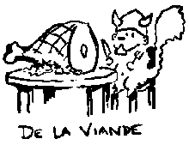
uses
Partitive articles are used both in English and in French to express quantities that cannot be counted. While the indefinite article (un, une, des) is used with countable quantities (un oeuf, deux oeufs …), the partitive article is used before mass nouns, nouns that are indivisible or uncountable. In English the article ‘some’ is often omitted.
| Edouard: Comme dessert, nous avons de la mousse au chocolat, de la glace parfumée à la vanille et du sorbet à l’ananas. | Edouard: For dessert, we have (some) chocolate mousse, vanilla ice cream, and pineapple sorbet. |
While the definite article designates something in its totality, or as a whole, the partitive article designates a part of the whole. Note that depending on what you want to say, the same noun may be introduced by a definite, indefinite, or a partitive article. Compare these examples:
| Edouard: Vous prenez du vin, n’est-ce pas? | partitive article |
Edouard: You are having (some) wine, aren’t you? (a quantity that is not specified) |
||
| Le vin rouge est bon pour la santé! | definite article |
Red wine is healthy! (‘wine’ in general) |
||
| En fait, nous avons un Beaujolais nouveau ou un Chambertin, un Châteauneuf-du-Pape, ou j’ai un excellent Médoc pour vous, ou un tout petit vin gris de Savoie. | indefinite article |
In fact, we have a Beaujolais nouveau, or a Chambertin, a Châteauneuf-du-Pape, or I have an excellent Médoc for you, or a little grey wine from Savoy. (These are items on the wine list, a countable quantity) |
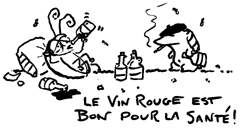
after the negative
In negative sentences, du, de la, des, de l’ change to de:
| Joe-Bob mange de la viande. | Tammy ne mange pas de viande. | Joe-Bob eats meat. Tammy does not eat meat. |
||
| Tex boit du café. | Tammy ne boit jamais de café. | Tex drinks coffee. Tammy never drinks coffee. |
||
| Il y a encore du vin. | Il n‘y a plus de vin. | There is some wine left. There is not any wine left. |
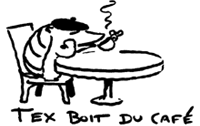
The partitive and indefinite articles may be used in negative sentences, however, to emphasize the contrasting positive noun. For example:
| Entre Tex et Tammy, ce n’est pas de l’amitié, c’est de l’amour! | Between Tex and Tammy, it is not friendship, it is love! | |
| Edouard sert du poulet, pas des escargots! | Edouard serves chicken, not snails! |
Notice the use of the partitive articles in the following dialogue.
| Tammy est au téléphone: Allô, Edouard? Je reçois des amis ce soir. Je voudrais faire des crêpes, mais j’ai oublié la recette. Tu peux m’aider? | Tammy is on the phone: Hello, Edouard? I’m having some friends over tonight. I would like to make some crêpes, but I’ve forgotten the recipe. Can you help me? | |
| Edouard: Rien de plus facile! Tu mélanges de la farine et des oeufs. Tu ajoutes ensuite du lait, du sel et de l’huile. Tu verses cette pâte dans une poêle. Quand la pâte est cuite, tu garnis la crêpe avec du fromage râpé, du jambon, ou des cèpes. Mais n’oublie pas Tammy, avec des crêpes, on ne boit pas de vin. Il faut boire du cidre et porter une coiffe bretonne! | Edouard: No problem! Mix some flour and eggs. Add some milk, some salt and some oil. Pour this batter in a pan. When the batter is cooked, fill the crêpe with some grated cheese, some ham, or cepes (mushrooms). But don’t forget Tammy, with crêpes, you don’t drink wine. You have to drink cider and wear a Breton hat! |
determiners: expressions of quantity
There are many ways of expressing quantity: numbers (deux crêpes), the indefinite article (un tatou, an armadillo), and the partitive article (du lait, some milk). Quantities may also be expressed using adverbs and adverbial expressions, such as assez (enough), beaucoup (a lot), or trop (too much).
When used with nouns, expressions of quantity are always followed by de (d’ if the noun begins with a vowel sound).
| Tammy et Tex reçoivent des amis ce soir. Tammy est dans la cuisine. Tex regarde la télévision. | Tammy and Tex are having some friends over tonight. Tammy is in the kitchen. Tex is watching television. | |
| Tammy: Une douzaine de crêpes, c’est trop pour quatre personnes? | Tammy: A dozen crepes, that’s too much for four people? | |
| Tex: Mais non, Tammy, ce n’est pas assez. Il faut préparer beaucoup de crêpes. | Tex: No, Tammy, it’s not enough. You can never prepare too many crepes. |
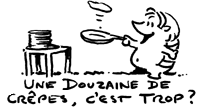
Here is a list of common adverbial expressions of quantity:
| assez de | enough |
| beaucoup de | a lot |
| un peu de | a little |
| plein de | many |
| un tas de | a lot of |
| trop de | too many |
Note that these expressions of quantity do not change in negative sentences:
| Tex: On ne prépare jamais trop de crêpes. | Tex: One never prepares too many crepes! |
One can express quantity by using specific nouns or adverbs of quantity, as well as measures of weight, distance, or volume, especially in reference to food. For example:
| une boîte de | a can (box) of |
| un bol de | a bowl of |
| un bout de | a piece (end) of |
| une bouteille de | a bottle of |
| une cuillère de | a teaspoon of |
| une douzaine de | a dozen |
| 50 grammes de | 50 grams of |
| un kilo de | a kilo of |
| un litre de | a liter of |
| une livre de | a pound of |
| un morceau de | a piece of |
| une part de | a serving of |
| une pincée de | a pinch of |
| une tasse de | a cup of |
| une tranche de | a slice of |
| un verre de | a glass of |
The definite article (le, la, les) may be used with these expressions to indicate a quantity of a specific item. Remember that de + le and de + les form the contractions du and des respectively.
| un morceau du gâteau qu’Edouard a préparé | a piece of the cake that Edouard made | |
| un verre du vin rouge, pas du blanc | a glass of the red wine, not the white one | |
| beaucoup des invités parlent français | many of the guests speak French |
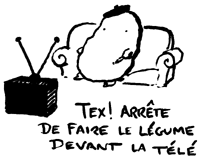
Listen to the dialogue:
| Tammy lit la recette: Pour une douzaine de crêpes, mélanger 400 grammes de farine et deux oeufs. Ajouter ensuite un demi litre de lait, une cuillère de sel et une cuillère d‘huile. | Tammy reads the recipe: For a dozen crêpes, mix 400 grams of flour and two eggs. Then add half a liter of milk, a spoonful of salt and a spoonful of oil. | |
| Tammy: Dis, Tex! Arrête de faire le légume devant la télé! Viens m’aider! | Tammy: Hey, Tex! Stop vegging out in front of the TV! Come and help me! | |
| Tex: Comment? J’ai fait mon travail, moi! Le bouquet de roses et la bouteille de cidre sont sur la table! | Tex: What? I did my job! The bouquet of flowers and the bottle of cider are on the table! |
-ir verbs (regular) present tense
Verbs with infinitives ending in -ir form a second group of regular verbs in French, often called ‘second conjugation’ verbs. To conjugate these verbs, drop the -ir from the infinitive and add the second conjugation present tense endings: -is, -is, -it, -issons, -issez, -issent. The singular and plural forms of the third person are clearly distinguishable (finit vs.finissent). Listen to the difference.
| finir ‘to finish’ | |
| je finis | nous finissons |
| tu finis | vous finissez |
| il/elle/on finit | ils/elles finissent |
| past participle : fini | |
Here is a list of other common -ir verbs:
| choisir | to choose |
| établir | to establish |
| grandir | to grow (up) |
| grossir | to gain weight |
| maigrir | to lose weight |
| mincir | to get slimmer |
| obéir (à quelqu’un) | to obey (someone) |
| réagir | to react |
| réfléchir | to think, reflect |
| réunir | to get together, assemble |
| réussir (à) | to succeed (at) |
| vieillir | to grow old |
Not all verbs ending in -ir follow this pattern, however. Irregular -ir verbs include ouvrir, partir, sortir, and dormir.
Listen carefully to the pronunciation of the verbs in the following dialogue. In particular, note the difference in the pronunciation of one s (pronounced as /z/) and two ss (pronounced as /s/) in the verb ‘choisir.‘
| Tex et Tammy réunissent des copains ce soir. | Tex and Tammy are getting friends together this evening. |
| Tammy: Quel vin tu choisis, Tex? | Tammy: What wine do you choose, Tex? |
| Tex réfléchit un moment, et puis il choisit un bon vin rouge. | Tex reflects a moment and then he chooses a good red wine. |
| Tex: Nous choisissons toujours du rouge. C’est bon pour la santé. | Tex: We always choose red (wine). It’s good for (one’s) health. |
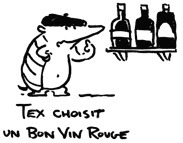
Listening Comprehension:
1
2
3
4
5
6
7
8
9
10
11
12
-re verbs (irregular) like prendre
Verbs like prendre are conjugated like regular -re verbs in the singular, but not in the plural. Note the difference in the stem in the plural forms.
| prendre ‘to take’ | |
| je prends | nous prenons |
| tu prends | vous prenez |
| il/elle/on prend | ils/elles prennent |
| past participle: pris | |
Verbs conjugated like prendre include:
| apprendre | to learn |
| comprendre | to understand |
| surprendre | to surprise |
| Edouard et Tammy surprennent Tex. | Edouard and Tammy surprise Tex. |
| Tammy: Qu’est-ce que tu fais, Tex? Tu vas où? Pourquoi tu prends un taxi? | Tammy: What are you doing, Tex? Where are you going? Why are you taking a taxi? |
| Tex: Uhh, je suis en retard. Uhh, je vais en classe. Aujourd’hui mes étudiants apprennent à chanter la Marseillaise! | Tex: Uhh, I’m late. Uhh, I’m going to class. Today my students are learning to sing the Marseillaise! |
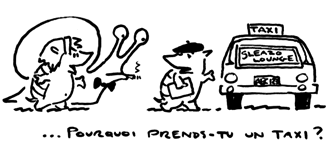
Listening Comprehension
1
2
3
4
5
6
7
8
9
10
11
12
boire, croire, voir
The irregular verbs boire, croire, and voir have similar conjugations. Listen carefully to their forms in the present tense.
| boire ‘to drink’ | |
| je bois | nous buvons |
| tu bois | vous buvez |
| il/elle/on boit | ils/elles boivent |
| past participle : bu | |
| croire ‘to believe’ | |
| je crois | nous croyons |
| tu crois | vous croyez |
| il/elle/on croit | ils/elles croient |
| past participle : cru | |
| voir ‘to see’ | |
| je vois | nous voyons |
| tu vois | vous voyez |
| il/elle/on voit | ils/elles voient |
| past participle : vu | |
| Fiona: Corey, tu as l’air malade! Mais qu’est-ce que tu bois? Hé, tu m’entends? Tu me vois? Oh, là, là, je crois qu’il va crever! | Fiona: Corey, you look sick! What are you drinking? Hey, do you hear me? Do you see me? Omigod, I think he’s gonna croak! |

interrogative words: où, quand, comment ….
Où (where), quand (when), comment (how), pourquoi (why), combien (how much), combien de (how many) may be used to ask questions with subject/verb inversion or with est-ce que. Note that the question word goes before est-ce que.
| Bette pose des questions à Edouard pour en savoir davantage sur Tex. | Bette asks Edouard questions to find out more about Tex. | |
| Bette: Où Tex est-il né? | Bette: Where was Tex born? | |
| Edouard: Comment? | Edouard: Pardon? | |
| Bette: Où est-ce que Tex est né? | Bette: Where was Tex born? | |
| Edouard: Au Texas. | Edouard: In Texas. | |
| Bette: Quand a-t-il rencontré Tammy? | Bette: When did he meet Tammy? | |
| Edouard: Comment? | Edouard: Pardon? | |
| Bette: Quand est-ce qu’il a rencontré Tammy? | Bette: When did he meet Tammy? | |
| Edouard: Il y a deux ans à Lyon. | Edouard: Two years ago in Lyon. | |
| Comment est-il venu aux Etats-Unis? | Bette: How did he come to the United States? | |
| Edouard: Qu’est-ce que tu as dit? | Edouard: What did you say? | |
| Comment est-ce qu’il est venu aux Etats-Unis? | Bette: How did he come to the United States? | |
| Edouard: Il a été expulsé de France! | Edouard: He was deported from France. | |
| Bette: Pourquoi porte-t-il toujours un béret? | Bette: Why does he always wear a beret? | |
| Edouard: Comment? | Edouard: Pardon? | |
| Bette: Pourquoi est-ce qu’il porte toujours un béret? | Bette: Why does he always wear a beret? | |
| Edouard: Il n’a pas de cheveux. Sans chapeau il risque des coups de soleil. | Edouard: He doesn’t have any hair. Without a hat he risks getting sunburned. | |
| Bette: Combien est-il payé? | Bette: How much is he paid? | |
| Edouard: Comment? | Edouard: Pardon? | |
| Bette: Combien est-ce qu’il est payé? | Bette: How much is he paid? | |
| Edouard: Pas assez. Les tuteurs sont mal payés. | Edouard: Not enough. Tutors are not paid well. | |
| Bette: Combien de cigarettes fume-t-il par jour? | Bette: How many cigarettes does he smoke every day? | |
| Edouard: Comment? | Edouard: Pardon? | |
| Bette: Combien de cigarettes est-ce qu’il fume par jour? | Bette: How many cigarettes does he smoke every day? | |
| Edouard: Je ne sais pas, mais il fume de moins en moins depuis son arrivée au Texas. Dis donc, tu es bien curieuse. | Edouard: I don’t know, but he’s smoking less and less since he came to Texas. Say, you are very curious. |

questions with subject/verb inversion
inversion
Formal questions may be asked by reversing the subject pronoun/verb order and linking the two with a hyphen. You may have already seen inversion in fixed expressions like the following greetings: ‘Comment allez-vous?’, ‘Comment vous appelez-vous?’, ‘Quelle heure est-il?’.
| Joe-Bob choisit ses cours pour le semestre prochain. | Joe-Bob is choosing his classes for next semester. | |
| Job-Bob: Corey, as-tu des idées? | Joe-Bob: Corey, do you have any ideas? | |
| Tammy et Bette, connaissez-vous de bons cours? | Tammy and Bette, do you know any good courses? |
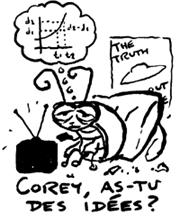
addition of -t- in third person singular
In the third person singular, when the verb ends in a vowel, a -t- is added to make the liaison possible.
| Corey se parle à lui-même: | Corey thinks to himself: | |
| Voyons. Joe-Bob aime-t-il les lettres? Non! | Let’s see. Does Joe-Bob like the humanities? No! | |
| A-t-il envie d’étudier les maths? Non! | Does he want to study math? No! | |
| Va-t-il devenir médecin? Oh, jamais! | Is he going to become a doctor? Oh, never! | |
| Aime-t-il les filles? Oui! | Does he like girls? Yes! | |
| Alors, j’ai une idée. | So, I have an idea. | |
| Corey: Joe-Bob … | Corey: Joe-Bob … | |
| Joe-Bob: Mmm. | Joe-Bob: Mmm. | |
| Corey: J’ai un cours pour toi: ‘La vie intime des animaux.’ | Corey: I have a course for you: ‘Animal Intimacy.’ |
addition of a pronoun with a noun or proper name
When the subject is a proper name or noun, the corresponding subject pronoun (il, elle, ils, or elles) is added for inversion with the verb.
| Joe-Bob: Et les belles filles suivent-elles ce cours? | Joe-Bob: Do pretty girls take this class? | |
| Corey: Oh, oui. | Corey: Oh, yes. | |
| Joe-Bob: Ce cours est-il difficile? | Joe-Bob: Is this class difficult? | |
| Corey: Oh, non ça. | Corey: Oh, no. |
compound tenses
In compound tenses, such as the passé composé, the subject pronoun is inverted with the auxiliary (the conjugated verb).
| Joe-Bob: Corey, as-tu suivi ce cours? | Joe-Bob: Corey, did you take this class? | |
| Corey: Oui, mais j’ai raté l’examen final. | Corey: Yes, but I flunked the final exam. |
negation
Ne precedes the conjugated verb and the second half of the negative (pas, jamais, plus, etc.) follows the pronoun.
| Joe-Bob: Pourquoi n’as-tu pas réussi l’examen? | Joe-Bob: Why didn’t you pass the exam? | |
| Corey: Oh, j’ai trouvé que l’examen était trop technique. Moi, je suis plus romantique que scientifique. | Corey: Oh, I thought that the exam was too technical. I am more romantic than scientific. |
‘est-ce’ and ‘y a-t-il’
The inverted forms of ‘c’est’ and ‘il y a’ are est-ce and y a-t-il.
| Joe-Bob: Est-ce possible? | Joe-Bob: Is this possible? | |
| N‘y a-t-il pas un seul cours facile pour moi? | Isn’t there a single easy course for me? |


